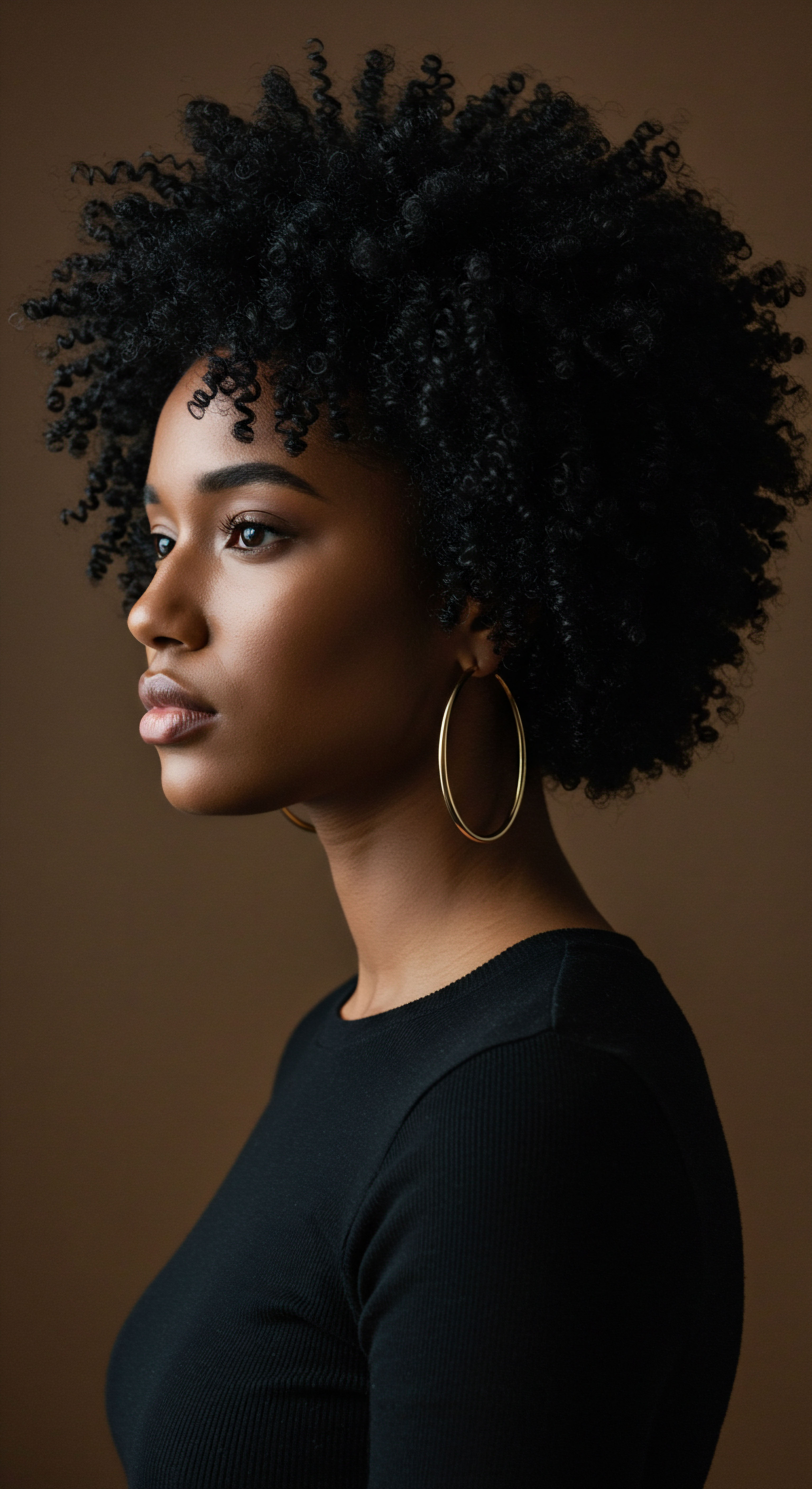
Roots
The gentle rhythm of night, the quiet surrender to slumber, holds a secret conversation with the very strands that adorn our heads. We often consider our hair a canvas for expression, a crown of identity, yet its profound connection to our body’s deepest biological rhythms often goes unnoticed. The active growth phase of hair, known as anagen, is a vibrant period of cellular activity, a time when follicles are diligently working to produce new, healthy strands.
This tireless work, however, does not happen in isolation. It is intimately connected to the unseen dance of our sleep cycles, a relationship far more intricate than a simple beauty rest.
Consider the microscopic world within each hair follicle, a tiny, self-contained organ that cycles through periods of vigorous growth, gentle transition, and quiet rest. This remarkable process, occurring independently for each strand, ensures that we do not shed all our hair at once, maintaining a relatively consistent density. The anagen phase stands as the most dynamic part of this cycle, a period lasting anywhere from two to eight years for scalp hair, where matrix cells rapidly divide and differentiate, pushing out the growing hair shaft. The vitality of this phase, its duration and efficiency, is profoundly influenced by the body’s internal environment, an environment significantly shaped by the quality and architecture of our sleep.

Hair Anatomy and Its Cycles
Each strand of hair originates from a specialized structure nestled within the skin ❉ the Hair Follicle. These tiny organs are more than mere anchors; they are complex biological factories, equipped with their own cellular machinery and responsive to systemic signals. At the base of the follicle lies the Dermal Papilla, a cluster of specialized cells that plays a pivotal role in controlling hair growth and size. Surrounding it are the hair matrix cells, which are among the fastest dividing cells in the human body, continuously producing the keratinocytes that form the hair shaft.
The hair growth cycle unfolds in distinct stages, a synchronized, yet asynchronous, ballet across the scalp:
- Anagen ❉ This is the active growth phase, characterized by rapid cell division in the hair matrix, leading to hair lengthening. For scalp hair, this phase typically lasts for years, determining the potential maximum length of one’s hair. During this period, the hair is firmly anchored within the follicle.
- Catagen ❉ A brief transitional phase, lasting a few weeks. Growth ceases, and the lower part of the follicle begins to regress. The hair separates from the dermal papilla, preparing for shedding.
- Telogen ❉ The resting phase, where the hair remains in the follicle but is no longer growing. This phase can last for several months. Towards its end, a new anagen hair often begins to form beneath the resting hair, eventually pushing it out.
- Exogen ❉ The final part of the telogen phase, when the old hair is actively shed.
The duration and health of the anagen phase are paramount for achieving and maintaining hair length and density. Disruptions at any point in this cycle can lead to changes in hair quality, thinning, or shedding.
The active growth phase of hair, anagen, relies on the body’s restorative processes that peak during sleep.

What are the Fundamental Sleep Stages?
Sleep, far from a passive state, is a dynamic and deeply restorative process, cycling through distinct stages, each with its own physiological signature and purpose. These stages are broadly categorized into Non-Rapid Eye Movement (NREM) sleep and Rapid Eye Movement (REM) sleep. A complete sleep cycle, typically lasting around 90 minutes, repeats several times throughout the night, with the distribution of stages shifting as the night progresses.
NREM sleep is further divided:
- N1 Light Sleep ❉ This is the initial, lightest stage of sleep, a transition from wakefulness where muscle activity slows and brain waves begin to decrease.
- N2 Light Sleep ❉ The majority of our sleep time is spent in this stage. Heart rate and body temperature decrease, and brain activity shows characteristic sleep spindles and K-complexes, believed to be involved in memory consolidation.
- N3 Deep Sleep (also known as slow-wave sleep) ❉ This is the deepest and most restorative stage of sleep. Brain waves are very slow (delta waves), and it is during this phase that the body undertakes significant physical repair and cellular regeneration. Essential growth hormones are released at their highest levels.
REM Sleep is distinct. During this stage, brain activity mirrors that of wakefulness, but the body experiences temporary muscle paralysis. This is when most vivid dreaming occurs.
REM sleep is important for cognitive functions, emotional regulation, and may also influence hormone production, including those that play a part in hair follicle regulation. The proper progression through these stages, particularly the restorative deep sleep, is intrinsically tied to the body’s capacity for cellular upkeep, including the tireless work of hair follicles.
| Hair Phase Anagen (Growth) |
| Description Active cell division, hair lengthening. |
| Sleep Connection Supported by deep NREM sleep for cellular repair and hormone release. |
| Hair Phase Catagen (Transition) |
| Description Growth stops, follicle regression begins. |
| Sleep Connection Influenced by metabolic factors that can be disrupted by poor sleep. |
| Hair Phase Telogen (Resting) |
| Description Hair remains dormant in follicle. |
| Sleep Connection Premature entry can be triggered by stress hormones elevated by sleep deprivation. |
| Hair Phase Exogen (Shedding) |
| Description Old hair sheds, new hair may begin. |
| Sleep Connection Disrupted by insufficient sleep, leading to increased shedding. |

Ritual
As we navigate the demands of daily life, the quiet hours of night often become a forgotten space, merely a pause between sunrises. Yet, within this stillness lies a powerful opportunity for restoration, a ritual that extends its gentle hand to every aspect of our wellbeing, including the vitality of our hair. The notion of “beauty sleep” is far from a mere saying; it is a testament to the body’s innate capacity for renewal, a capacity profoundly influenced by our sleep practices. Understanding this deep link allows us to approach our nighttime routines not as a chore, but as a deliberate act of care, a gentle practice that supports the anagen phase of hair growth.
For textured hair, this connection carries particular resonance. The unique structure of coils, curls, and waves often presents distinct needs for moisture retention, breakage prevention, and gentle handling. The rituals we adopt before and during sleep can significantly impact the health of these strands, ensuring that the biological processes of the anagen phase are supported rather than hindered. A thoughtful evening regimen, therefore, becomes a conscious act of nourishing not just the visible hair, but the very foundation of its growth.

How does Sleep Quality Affect Hair Growth?
The quality of our sleep directly influences the body’s ability to maintain and promote the anagen phase of hair growth. During deep sleep, the body prioritizes essential functions like cellular repair and regeneration. This includes the diligent work of hair follicles, which require a consistent supply of nutrients and a stable hormonal environment to sustain their active growth. When sleep is consistently disrupted, these restorative processes falter, impacting the efficiency and duration of the anagen phase.
One significant consequence of poor sleep is the elevation of Cortisol, often referred to as the stress hormone. Prolonged high cortisol levels are known to disrupt the hair growth cycle, potentially pushing hair follicles prematurely from the anagen phase into the resting (telogen) phase. This can result in increased shedding, a condition often referred to as Telogen Effluvium. Conversely, consistent, quality sleep helps regulate cortisol, allowing the hair cycle to proceed uninterrupted.
Quality sleep fosters a balanced internal environment, which is essential for the active anagen phase of hair growth.
Beyond hormonal balance, sleep also influences blood circulation. During restful sleep, blood flow to the scalp increases, delivering oxygen and vital nutrients directly to the hair follicles. This nourishment is crucial for the vigorous metabolic activity required during the anagen phase. Insufficient sleep can hinder this circulation, depriving follicles of the sustenance they need for optimal growth.

Nighttime Care for Textured Hair
The deliberate practice of nighttime hair care, especially for textured hair, extends the benefits of quality sleep to the physical integrity of the strands. Textured hair, with its inherent curves and bends, is often more prone to dryness and mechanical breakage. A thoughtful evening ritual can significantly mitigate these challenges.
- Moisture Retention ❉ Before bed, consider applying a lightweight leave-in conditioner or a natural oil to the hair. This helps to seal in moisture, counteracting the natural dehydration that can occur overnight. For textured hair, this step is particularly beneficial in maintaining elasticity and preventing brittleness.
- Protective Styling ❉ Loose braids, twists, or pineapple styles can protect hair from friction against bedding. These styles minimize tangling and breakage, preserving the length and health of the strands.
- Silk or Satin Protection ❉ Swapping cotton pillowcases for silk or satin alternatives is a gentle yet powerful adjustment. These smoother fabrics reduce friction, which in turn minimizes frizz, tangles, and breakage that can compromise hair health. Wearing a silk or satin bonnet or scarf offers similar protection, creating a gentle cocoon for your hair.
These practices work in concert with the body’s internal restorative processes during sleep. By reducing external stressors and providing optimal conditions, we support the hair follicle’s ability to remain in the anagen phase for its full potential duration.
| Factor Hormonal Balance |
| Impact of Good Sleep Promotes balanced melatonin, growth hormone, and lower cortisol. |
| Impact of Poor Sleep Elevates cortisol, disrupts melatonin and growth hormone. |
| Factor Cellular Repair |
| Impact of Good Sleep Optimizes regeneration of hair follicle cells. |
| Impact of Poor Sleep Hindered repair, less efficient regeneration. |
| Factor Blood Circulation |
| Impact of Good Sleep Increases blood flow to scalp, delivering nutrients. |
| Impact of Poor Sleep Reduced blood flow, nutrient deprivation for follicles. |

Relay
Beyond the visible practices and the foundational understanding of hair growth, lies a deeper, more intricate conversation between our sleep and the very machinery of our hair. How precisely do the quiet hours of night, governed by the ebb and flow of our sleep stages, communicate with the industrious hair follicles, particularly during their anagen phase? This question invites us into a complex interplay of hormones, cellular signaling, and circadian rhythms, a sophisticated dance that dictates the very lifespan and vitality of each strand. For textured hair, with its distinct structural demands and often unique responses to physiological stressors, understanding these underlying biological dialogues becomes even more compelling.
The biological connection is not a simple switch, but a cascade of finely tuned events. Sleep is not merely a state of rest for the body; it is a period of active repair, synthesis, and regulation, all of which directly or indirectly influence the anagen phase. This influence extends from the macroscopic hormonal shifts to the microscopic activity of stem cells within the follicle, revealing a profound partnership between our nightly repose and the flourishing of our hair.

How do Hormones during Sleep Affect the Anagen Phase?
The sleeping body orchestrates a symphony of hormonal releases, many of which directly impact the anagen phase. These chemical messengers serve as crucial links between our sleep architecture and the activity within our hair follicles.
- Growth Hormone (GH) ❉ Primarily released during deep NREM sleep, GH is a potent anabolic hormone. It plays a central role in cellular repair and regeneration throughout the body, including the rapid proliferation of matrix cells within the hair follicle. Sufficient deep sleep ensures optimal GH release, thereby providing the necessary impetus for robust anagen growth.
- Melatonin ❉ This hormone, well-known for regulating sleep-wake cycles, also holds significant sway over hair growth. Melatonin receptors are present in human hair follicles, suggesting a direct role in regulating the hair cycle. Research indicates that melatonin can prolong the anagen phase and delay the onset of catagen and telogen, thereby supporting longer, more sustained hair growth. Its antioxidant properties also protect hair follicles from oxidative stress, a factor that can damage cells and lead to premature hair loss.
- Cortisol ❉ As discussed, elevated cortisol levels, often a result of sleep deprivation or chronic stress, can prematurely push hair follicles into the resting phase. This shortening of the anagen phase leads to increased shedding, a phenomenon particularly pronounced in conditions like telogen effluvium. Regulated sleep helps keep cortisol levels in check, fostering an environment conducive to sustained anagen.
The balance of these hormones, precisely calibrated during healthy sleep, provides the biochemical backdrop for optimal anagen activity. When this balance is disturbed, the hair cycle can become dysregulated, manifesting as changes in hair density and quality.

What Role do Circadian Rhythms Play in Hair Follicle Activity?
Beyond the immediate effects of sleep stages and hormones, the broader influence of the body’s internal clock, the Circadian Rhythm, holds a profound sway over hair follicle activity. This 24-hour cycle, influenced by light and darkness, regulates numerous physiological processes, including cell proliferation and metabolic homeostasis. Hair follicles themselves possess their own intrinsic circadian clocks, allowing them to respond to these rhythmic signals.
Research highlights that circadian clock genes, such as BMAL1 and PER1, are expressed within hair follicles and play a role in modulating the progression of the hair growth cycle. These genes influence how hair stem cells are activated or deactivated, thereby controlling the hair growth cycles. Disruptions to these internal clocks, as seen in shift workers or individuals with chronic sleep disturbances, can decrease stem cell activity in hair follicles, potentially reducing their regenerative capacity over time.
The intricate dance between sleep stages and hair’s growth phase is a testament to the body’s deep biological synchronicity.
A compelling example of this intricate connection comes from a 2019 study published in Cell Reports. This research demonstrated a link between Circadian Rhythm Disruptions, such as those experienced by shift workers, and decreased stem cell activity within hair follicles. The study suggested that chronic disruption can reduce the regenerative capacity of these cells over time, potentially resulting in thinner, weaker hair.
This data point, often overlooked in general hair care discussions, underscores the systemic and profound influence of our internal biological clock on the very engines of hair growth. It suggests that consistent sleep patterns are not merely about feeling rested, but about providing a stable rhythmic signal that supports the hair follicle’s ability to maintain its regenerative prowess.
The cellular environment within the hair follicle is also affected by sleep. During deep sleep, cellular repair mechanisms are heightened, addressing daily wear and tear. This includes the repair of DNA and proteins within the rapidly dividing matrix cells. Additionally, sleep supports healthy blood circulation to the scalp, ensuring a steady supply of oxygen and nutrients, which are indispensable for the high metabolic demands of the anagen phase.
For diverse hair types, particularly textured hair, these biological connections carry added weight. The unique coiled and twisted structure of textured hair can make it more susceptible to environmental stressors and mechanical damage. Optimal cellular repair, robust stem cell activity, and a stable hormonal environment, all supported by quality sleep, become even more paramount for maintaining the integrity and promoting the healthy growth of these distinctive strands. The biological dialogue between sleep and the anagen phase is a universal one, yet its expression and the visible outcomes can differ subtly across the spectrum of hair types, making a holistic, informed approach to sleep a cornerstone of hair wellness for all.
| Hormone Growth Hormone (GH) |
| Primary Sleep Stage Release Deep NREM Sleep |
| Anagen Phase Influence Stimulates cell proliferation in hair matrix, supports tissue growth. |
| Hormone Melatonin |
| Primary Sleep Stage Release Activated by darkness, regulates sleep-wake cycles |
| Anagen Phase Influence Prolongs anagen, protects follicles from oxidative stress, modulates hair cycle. |
| Hormone Cortisol |
| Primary Sleep Stage Release Elevated by sleep deprivation, stress hormone |
| Anagen Phase Influence Shortens anagen, pushes follicles into resting phase, increases shedding. |

Reflection
The quietude of night holds more than just rest; it contains a hidden reservoir of vitality for our hair. The journey through the anagen phase, that period of vibrant growth, is profoundly shaped by the silent, intricate processes that unfold within our sleeping bodies. From the rhythmic release of hormones to the subtle dance of circadian genes within each follicle, our nightly surrender to slumber is a deep, biological conversation with the very essence of our strands.
To truly understand and honor our hair, especially the diverse textures that tell stories of heritage and individuality, means acknowledging this powerful, often overlooked, connection to our sleep. It is a reminder that wellness is not segmented, but a fluid, interconnected flow, where the peace we find in the dark directly translates to the strength and radiance we carry into the light.

References
- Fischer, T. W. Burmeister, G. Schmidt, N. Hempel, B. and K. H. W. (2012). Melatonin increases anagen hair rate in women with androgenetic alopecia or diffuse alopecia ❉ Results of a pilot randomized controlled trial. International Journal of Trichology, 4(3), 133–138.
- Hardy, M. H. (1992). The Secret Life of the Hair Follicle. Trends in Genetics, 8(2), 55-61.
- Paus, R. & Cotsarelis, G. (2008). The Biology of Hair Follicles. New England Journal of Medicine, 359(10), 1042-1051.
- Oh, J. W. Kloepper, J. E. Langan, E. A. & Paus, R. (2016). A Guide to Studying Human Hair Follicle Cycling In Vitro. Journal of Investigative Dermatology, 136(2), 384–391.
- Plikus, M. V. Gay, D. L. Treutlein, B. Fleck, J. S. Krall, J. A. Quist, C. E. & Chuong, C. M. (2013). New life for old hairs ❉ The hair follicle stem cell niche and its regulation. Developmental Cell, 24(5), 451-464.
- Wang, X. Huang, J. & Cai, W. (2023). Hair Follicles as a Critical Model for Monitoring the Circadian Clock. International Journal of Molecular Sciences, 24(3), 2828.
- Yano, K. Brown, L. & Nishimura, E. K. (2019). Circadian rhythm disruption decreases hair follicle stem cell activity. Cell Reports, 26(10), 2639-2651.e5.
- Yang, J. Yang, J. & Yang, S. (2020). Relationship between the molecular circadian clock and hair cycle. Clinical and Experimental Dermatology, 45(8), 957-964.
- Sivaprasad, R. & Sarma, P. (2020). Hair Disorders ❉ A Comprehensive Guide. Jaypee Brothers Medical Publishers.
- Messenger, A. G. & de Berker, D. A. (2010). The biology of hair follicles. In R. Dawber (Ed.), Diseases of the Hair and Scalp (pp. 1-32). Blackwell Publishing.